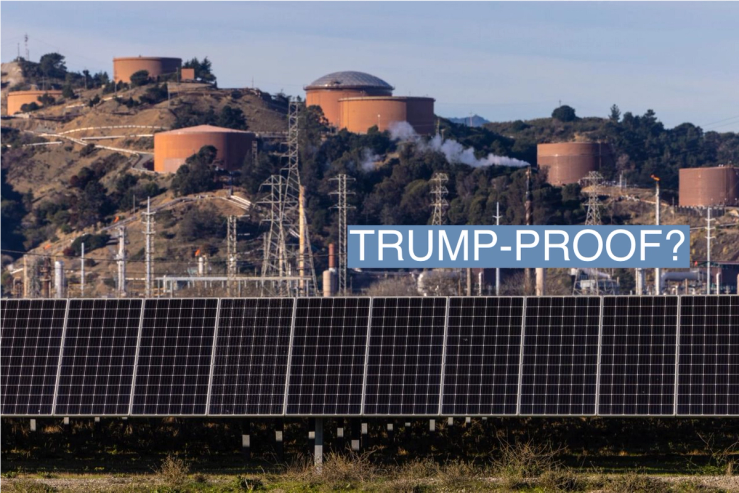The Facts
The headline-grabbing promise of the COP28 agreement — that countries will endeavor to “transition away from fossil fuels” — doesn’t come with a specific deadline. But another part of the agreement does. The deal says annual global greenhouse emissions need to peak by 2025 to stay within the global warming limit of 1.5 C. That means for the biggest emitters, 2024 will be a critical turning point for the energy transition, in which it will either speed up or miss the window of opportunity to keep 1.5 C within reach.
In this article:
Tim’s view
This year was a challenging one for the energy transition, pitting the human and economic costs of climate change against the big picture conditions of the global economy — war and nationalism, high inflation and interest rates — that tend to favor the fossil-fuel status quo. Those headwinds are unlikely to let up in 2024. These are the big questions that will shape whether COP28’s aspirations will remain within reach.
- Will global climate trade wars continue to heat up? Next year will be the first that European importers of industrial products like aluminum and fertilizer will need to report the carbon footprint of those goods. That reporting requirement will put pressure on suppliers around the world to start to decarbonize or risk losing market access when the EU’s carbon border tariff goes into full effect in 2026. The U.K. has outlined plans for its own version, and expect to see more political momentum to erect similar barriers in the United States. Meanwhile, Western companies and governments will continue to try to undermine China’s vise grip on the supply chains for critical minerals and clean energy hardware, which could drive prices up in the near term, especially if Beijing weighs additional export restrictions of its own.
- Can clean-energy investors recover their nerves? Even though the costs of solar power hardware have fallen to record lows, and there have never been more government incentives for clean energy, investment in the sector is at risk of stalling out. Rising borrowing costs make the economics of renewable energy projects less attractive, and U.S. regulators are weighing new banking rules that could restrict lending even more. Share prices of clean energy companies have suffered this year, and in 2024 global clean energy investment could fall 9%, according to a forecast this week by the Swedish bank SEB. But the story isn’t all bad. Climate tech is drawing a growing share of venture capital investment, and there is enormous appetite from high-emitting companies to acquire decarbonization solutions. Climate removal tech had a banner year in 2023, and will probably have another in 2024. Investment in clean energy manufacturing facilities in the U.S. has been growing steadily and will likely continue next year as well.
- Will EVs reach a sales tipping point or sit on dealer lots? Starting Jan. 1, most electric vehicles for sale in the U.S. will lose eligibility for the full $7,500 tax credit they qualified for this year, as rules to exclude China-produced components become more strict. Sales are expected to continue rising anyway, but at a slower pace, according to BloombergNEF: A 32% gain in 2024, compared with 47% in 2023. That leaves major automakers in a bind, as they struggle to set the right pace for their EV investments. EVs are piling up on dealership lots. But automakers are still engaged in a protracted price-cutting war to defend their market share against discount EV options from China. Those price cuts, plus a loophole that allows leased EVs to remain eligible for tax credits, along with the plummeting costs of batteries, will all be wins for consumers in 2024. And they’re a powerful driver of the transition away from fossil fuels, as the electrification of transportation takes a major bite out of oil demand.
- How will oil and gas companies balance current demand with long-term investment risk? biggest long-term gas contract
- Can the transition survive the U.S. presidential election? If Donald Trump wins another stint in the White House, it will set up a test of how resilient the long-term energy transition is to short-term politics. Clean energy is much cheaper than it was during Trump’s first term, and the Inflation Reduction Act has driven a surge in onshoring and re-industrialization that make the economic benefits of the transition much more tangible to more voters. So to some extent, there may be a limit to how much damage Trump can do. But there are plenty of areas where his administration could impede climate progress: Trump may be unwilling or uninterested in finding a bipartisan solution to permitting reform; he could toss or simply not enforce Biden-era emissions regulations from the Environmental Protection Agency; and could withdraw the U.S. from the Paris Agreement and from climate-focused trade deals with the EU.
The View From India
For countries in the global south, a key determinant of when they’ll hit peak emissions is foreign investment and financial aid. The COP28 agreement was roundly criticized by developing country governments for being vague and noncommittal about climate finance, essentially letting the U.S. and other rich big emitters off the hook for underwriting developing countries’ adoption of clean energy. The UAE and other Gulf oil exporters, meanwhile, seem more than happy to fill that development finance void with investments in fossil fuel infrastructure, for example with a $50 billion investment to build the world’s largest oil refinery in India. If the U.S. can’t step up its climate finance game, in other words, it risks not just undermining decarbonization in the countries with some of the fastest growing populations and energy demand, but also giving up significant geopolitical leverage.


